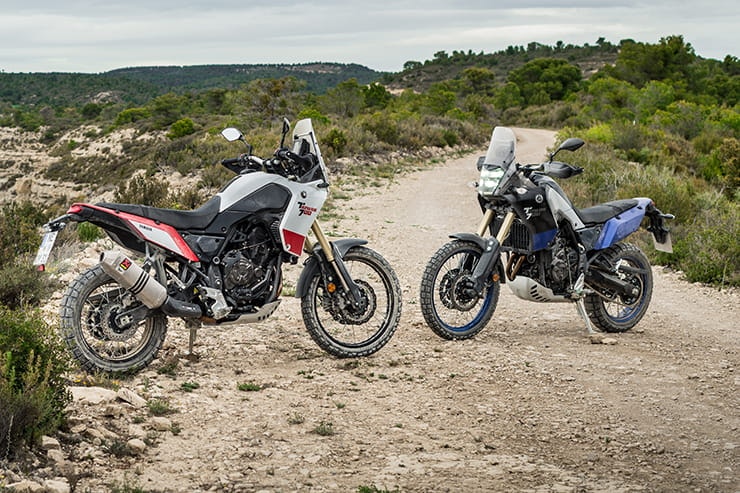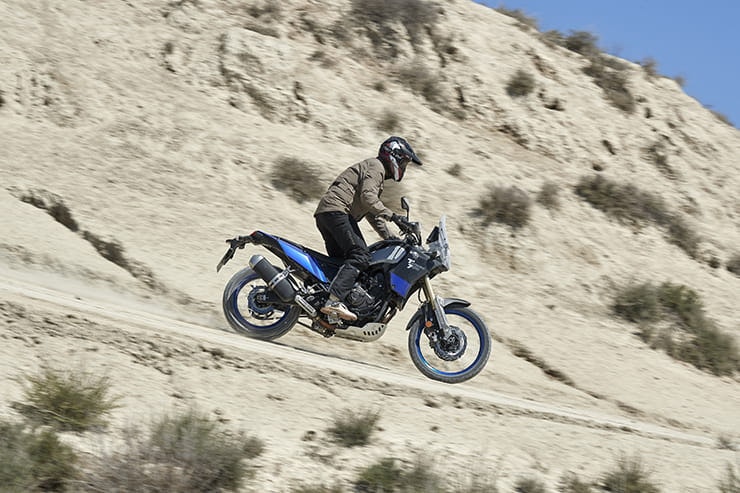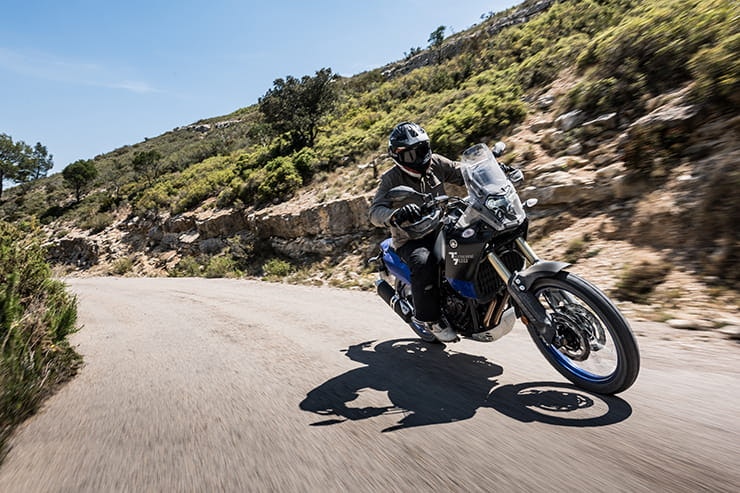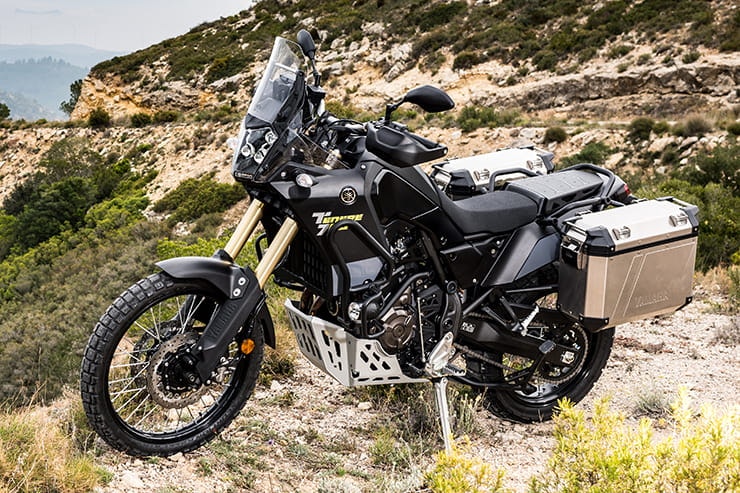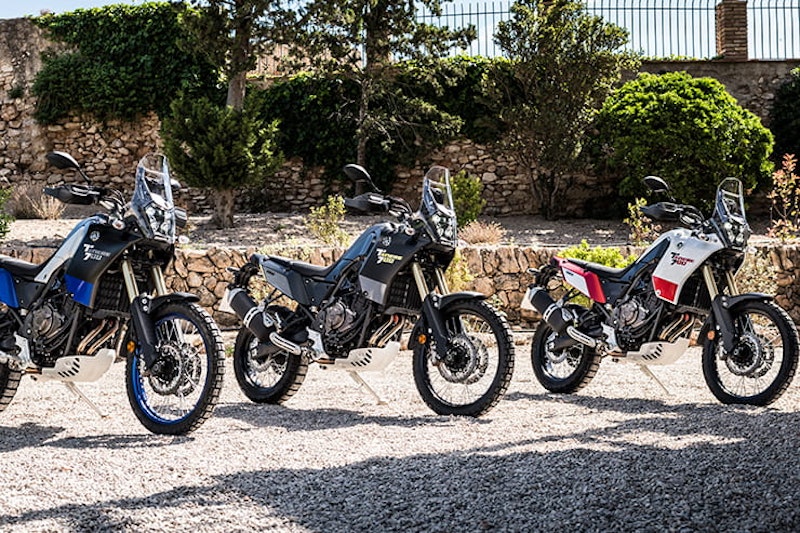Yamaha Ténéré 700 (2019) - Review
BikeSocial Road Tester
15.06.2020
Yamaha’s long-awaited, eagerly anticipated Ténéré 700 has finally arrived, launched over two days and 300 miles of riding on- and off-road in the hills and trails around Tarragona, Spain. And, because it’s taken so long to get here, we’ve had plenty of time to think of questions: is it an MT-07 on stilts? Is it the spiritual successor to the XTZ660? Is it an entry-level adventure bike? Why’s it taken Yamaha so long? And how does it compare to the current crop of mid-sized adventure bikes?
All these questions, and many more, can now be answered. Right here, right now.
Yamaha Ténéré 700 Price and Availability
Handling: frame, suspension and weight
Styling, ergonomics and comfort
2019 Yamaha Ténéré 700: Equipment and verdict
2019 Yamaha Ténéré 700: UK Road Test
VIDEO review from the press launch
What's it like to ride on and off road? Why not take a look with our reporter, Simon Hargreaves.
Yamaha Ténéré 700 Price and Availability
Available via online ordering system from March 27th to July 31st 2019. Subsequently in dealers from September 2019.
OTR: £9147
Colours: competition white (red/white), ceramic ice (blue/silver) or power black (black)
Typical PCP deal on Yamaha finance with a £1500 deposit over 36 months means a monthly payment of £165.23 and a final payment of £2789.84. APR is 6.9%
Power and torque (claimed)
72.4bhp @ 9000rpm
50.2 lb.ft @ 6500rpm
Engine, gearbox and exhaust
The Ténéré 700’s motor is a straight lift from the popular MT-07; the only modifications are a reshaped air-box and exhaust, to suit new frame and design packaging, and updated fuel injection mapping to suit trees and whales. Everything else is the same: 270°-crank, eight-valve, 689cc parallel twin making a shade over 72bhp and 50 lb.ft of torque.
Which means the Ténéré’s motive power unit is a) familiar to many riders, b) down on performance compared to almost all other adventure bikes, and c) is a well-known, well-proven and, indeed, well-loved machine. If you invest in a Ténéré 700 you can be pretty sure, short of a nuclear blast, it won’t break down and you won’t even need to think about valve clearances until 25,000 miles down the line. There are a few other adventure bikes whose mechanical solidity you might struggle to be as convincing about.
But there are plenty that make more power: KTM’s 94bhp 790 Adventure, Honda’s 94bhp Africa Twin, Triumph’s 94bhp Tiger 800 for a start. All of them are also better-equipped in terms of extras than the Ténéré 700 (traction control, flat screens, engine modes, cruise control, quickshifters etc), but only the Tiger 900 can get close to its £9147 price tag (although the outgoing Tiger 800 is still listed by Triumph at £9200). Yamaha call it balance, we can call it compromise. But more of all that, later.
In the meantime the on and off-road reality is, like the MT-07, the Ténéré’s motor is a narrow, lightweight, funky, chirpy little thing, forever cheerily optimistic as it bobs up and down the rev range with an eager, well-mannered obedience. It’s the kind of engine wears a permanent grin on its face – never a snarl, scowl, furrowed brow or even so much as a hint of annoyance. Primary vibration is minimal, tamed by a balancer shaft, but that offbeat 270° crank interval delivers just enough wonky, V-twin-esque lopsidedness to the Ténéré’s power pulses to be charismatic rather than asthmatic.
Yamaha lump the Ténéré’s motor, designated CP2, into their ‘crossplane’ crank philosophy – but it isn’t really; instead of pistons rising and falling together – 360° – or in direct opposition – 180° – they move in a staggered order, one trailing the other, never stationary at the same time (yes, unless you turn the engine off, fair point). The advantages over 360° and 180° layouts are mostly vibration-related; primary vibes are reduced with a balancer, secondary vibration is cancelled-out, and a rocking couple gives the Ténéré its ‘pleasing’ lumpy character. Yamaha were the first manufacturer in the modern era to introduce a 270° firing interval, first on the TRX850 in 1995 and on every parallel twin since, including the 1200cc XTZ1200 Super Ténéré – but there’s a more historical off-road connection too; Yamaha’s four-time Dakar-winning XTZ850R also ran a TDM/TRX-based 270° crank.
But don’t think for a second all that lack of aggression and bark – in notable contrast to, say, KTM’s hilariously rampant but possibly, for some people, slightly demanding 790 Adventure – makes Jack’s Ténéré 700 a dull boy. The engine is so cheerful it’s impossible to ride the 700 with anything other than a matching grin. Yamaha’s post-2008 credit crunch rebirth – which saw them draw a line under many of their old models and create the MT range from scratch – has been focused on building bikes that put a willful dynamism at their core. The whole ‘Revs Your Heart’ brand motto is easily discounted as just more PR bobbins, but if you think about MTs, Tracers and XSRs – whether it’s got a 7, 9 or 10 in the name – they all have varying degrees of loopiness about them, and are all up for a good time in one way or another.
The Ténéré 700 is no different. Wheelies – which of course Bikesocial can’t condone or recommend, much, often – are a mere throttle and a helpful rise in the road away in first or second. Long may it continue – or at least well into third.
The 689cc motor is tractable too – its ability to dig in and chug from a whisker of finely tuned throttle in third gear without subsequently running away on a whiskey grip gives the Ténéré proper offer chops for entry-level off road riders. It’s a benevolent engine, ideal for building confidence – controllable, benign, and willing.
On the road, the motor’s gearing – it’s running shorter 46/15 final drive against the MT-09’s 43/16 – balances top gear roll-ons with that bottom gear drive in the rough; 90mph pops up at around 7000rpm. It’s smooth enough and fast enough to easily contemplate longer rides – the NC500 is within easy reach of the Ténéré’s performance bracket. So’s the Pyrenees, but it might take a bit effort than the Yamaha’s aforementioned rivals: I’d prefer a Tiger 800 or Africa Twin for multiple long-distance rides.
Economy
The Ténéré’s tank is 16 litres, with 4.3 litres in reserve. The six segment fuel gauge starts flashing after 140 miles, which means it’s got around 50 miles until it runs dry and is managing 54mpg; comforting to know it’s got over 25% left of a theoretical 190-mile tank range. However, the onboard fuel consumption measures itself at an average 37.3mpg – admittedly the motor spent a lot of time in second and third gear off road, but that’s a bit pessimistic.
Handling: frame, suspension and weight
Now we get to the meat of the new Ténéré 700 – how it handles and how it manages the compromise/balance between road and off-road. Which, ultimately, is what we’ve all been waiting to know.
As it turns out, it’s also why Yamaha say they took so long to drag the Ténéré 700 into production; after all, they already had the engine. All they needed to do was put it in a chassis. Project leader Takushiro Shiraishi – who also worked on developing the XT660R and X back in day – is refreshingly honest about the Ténéré’s long lead time:
“There are two reasons. Everyone knew the MT-07 was also suitable for an off-road model, but we have limited human resources and there are a lot of models and categories we need to give priority to. This is one reason!
“The second reason is this model was really difficult. Today you’ve ridden it and you say, ‘Oh, it’s fun on road, it’s fun off-road... how do you create this kind of magic for both?’ – it’s really difficult. If you see other models – for example KTM – maybe off-road it could be very exciting. But on road, maybe a bit annoying or stressful. If you see Africa Twin – it’s a really good bike on the road; very comfortable – but off-road... it’s kind of demanding. The weight is heavy, the ergonomics are touring oriented. So for us it’s difficult to find the good balance – or is it compromise, I don’t know – it’s a really small hole to find the good balance between those two. So we needed a lot of effort to find this good balancing point. It was tough for us.”
But, say we, these are not new compromises, and there’s nothing new or radical in the Ténéré 700. It’s not as if Yamaha had to uncover some new engineering secret. Shiraishi-san continues:
“The difficulty is two things: one, the strength required for an off-road model is really hard compared to an on-road model. At the same time, low weight is really important for the off-road model. So we have to find a balance between the two: it’s a challenge to balance weight and strength. The second point is the balance between agility and stability. It’s easy to make it one or the other – we can make it agile, but then at speed on the highway it can become a safety problem. So this balance is also hard because it is 180° opposite. So we make many changes to steering head pipe position and steering angle, swingarm length, wheelbase...”
And all within a price point – presumably the final cost of the bike was already fixed?
“Yes, we had a target.”
And it’s fair to say Yamaha have hit the bullseye. The Ténéré’s steel tube frame and aluminium swingarm are bespoke, not an adapted road bike. Significant strengthening around the headstock and specific tuning of the frame to give flex and rigidity where needed took up time – but most eyes will immediately be drawn to a pair of bolted frame down-tubes that initially look like a double cradle, but which don’t actually meet the swingarm plates but bolt to the beefy, substantial, forged footrest hangers. Shiraishi-san explains:
“These of course add some strength to the frame, but they are mainly there to protect the engine, and we can mount the skid plate (aluminium, not plastic!) on them – some other bikes have the skid plate mounted on the engine, which I don’t understand because if it breaks, it breaks the engine also!”
I don’t think I’ve ever heard of frame elements described doubling up as engine protectors before; in a way, they all do. But it’s a sensible and innovative touch that, when your Ténéré’s lying on its side, you one day might be grateful for.
So does all the effort Shiraishi-san and his team have put into the Ténéré work?
Very much yes, it does. Even with a claimed kerb weight of 205kg – give or take the same as the XTZ660 and impressive considering one’s a twin and one’s a single – the Ténéré 700 is accomplished, agile and stable on and off-road. The suspension – big 43mm KYB upside downers at the front, KYB monoshock at the back, and both fully adjustable for preload and rebound and compression damping – is different league of competence to the collapsible XTZ660: if anything, the set-up on the launch Ténéré is verging on firm – some of the Spanish road surfaces are so derelict it’s hard to tell how good rid quality really is. On the smooth stuff, it’s really smooth and on rough stuff it’s well-damped. Which is what you want if it’s control you’re after, come to think of it.
Controlling weight transfer is another road/off-road compromise: long travel suspension for good ground clearance – of which there’s plenty – can mean pogo-ing on the brakes, changing direction and getting on the gas. And if the Ténéré’s suspension was in any way on the cheap, it would show up instantly.
It doesn’t. Yes, there is weight transfer and yes, the front 21in Pirelli Scorpion Rally has its work cut out, and no, you won’t want to be testing the limits of trail braking too often – but for a gangly £8399 middleweight entry level adventure bike, the Ténéré 700 handles crazy-ass apex-to-apex road scratching with considerable expertise. Of course conventional road bikes would be faster, but the Ténéré’s obvious limits are well sign-posted and faster than you’d imagine; the plot can be cornered with enough gusto to impress almost all committed road riders.
Off-road, the story is the same – the only significant limits to the Ténéré’s handling are mitigated by its engine performance; you’re unlikely to ride into trouble because the bike is so easy-going and capable. Firm, agile and relatively lithe – but with enough chassis mass to soak up ride incompetence, the Ténéré sits comfortably between the knees and is a doddle to guide around Spain’s high-speed gravel trails.
Styling, ergonomics and comfort
The Ténéré’s not quite as civilized when speeds are lower – first gear hairpins over larger, lumpy rock and gravel tracks are a bit tricky, partly because weight counts against you more the slower you go, and partly because the Ténéré’s riding position is – it’s that c-word again – another compromise. The bike comes with its bars set too low for a 6ft rider; it’s a stoop to stand on the pegs and reach down to them, robbing control. After a few hours, Yamaha staff find an Allen key rotate the bars upwards, which improves matters a lot. A pair of Yamaha accessory bar risers would finish the job – and don’t make the Ténéré any less comfy on the road.
Comfort is important on an adventure bike and, again, it’s a balance between the demands of on and off-road. A low seat height is essential to allow a wide range of customers fit the bike and feel comfortable with it; it’s especially important if the bike is an entry-level adventure machine.
At 875mm, the Ténéré sounds tall – but because the MT-07 motor is so slim, the actual stand-over isn’t as intimidating as it sounds. I can get both feet flat on the floor; for a lower seat height, Yamaha make a low (thinner) seat/longer tie-bars to drop the back end by 35mm down to 840mm. After 300 miles in two days – including a good seven-hour riding stint on and off-road, stood up and sat down, in 25°C heat – the Ténéré still feels fresh and rideable. The seat is narrow but firm, wind resistance from the screen and side deflectors is good for a traillie – you’re more exposed than some adventure bikes; but by the same token there’s less stuff to smash off when your Ténéré falls over. Mine didn’t, but you never know...
Styling-wise, the Ténéré comes in three colours: black, blue/silver and red/white. The latter is by far the prettiest, with a vaguely 1980s Marlboro thing going on. It’s hugely cool and I definitely would. The other two are a bit more workmanlike and less glitzy.
Brakes, wheels and tyres
Fairly straightforward stopping spec: brakes are a pair of 282mm wavy discs gripped by two-piston sliding calipers; much more braking performance would overwhelm the skinny front – the balance is perfect as it is. The Ténéré’s 21in front gives the bike proper off-road kudos and although it compromises road performance, the Pirelli Scorpion Rally tyres cope well with the twin demands of tarmac scratching and trail bashing. Acknowledging the reality of off-road, Yamaha have made the front hugger height-adjustable via four bolts, so clearance can be increased in mud. They’ve also added finger-holds to the underside of the rear subframe panels, for a handhold when pulling the bike upright after a fall.
2019 Yamaha Ténéré 700: Equipment and verdict
And so we arrive at the final Ténéré compromise: price versus spec. When launched in 2019 its £8399 ticket was substantially less than the competition. For 2020, the Tenere’s price has risen by £750. You don’t get a colour TFT dash, traction control, engine modes, a slipper-assist clutch, cruise control, quick shifter, Bluetooth, heated grips or an adjustable screen. The centre stand is an accessory. The lift-out filler cap has no hinge. If all that matters, look elsewhere. Almost anywhere. You do get quad LED headlamps, which look whizz.
Equally, if you’re more of a dedicated trail rider looking to extend your abilities you’ll already know you should be looking more towards a pure enduro bike; say a WR250 and a van to cart it about; than a Ténéré 700.
But as an entry-level, affordable, unsophisticated my-first-adventure-bike that does the basics of performance and handling to a high degree of confidence both on and off-road – which is no mean feat of development in itself, whatever the price – the Ténéré 700 is pretty much in a class of one. And if you want a bike you can ride in comfort to Yamaha’s Off-Road Experience centre in Wales – and it’s amazing, why wouldn’t you? – and then take it on the trails and tracks themselves... actually, that’s a really good idea. Count me in.
Three things I love about Yamaha's Ténéré 700
engine – just brilliant fun from the eternally cheerful parallel twin
looks – the red and white bike is just lovely
on/off-road ability – Yamaha call it balance, I call it brilliantly satisfying compromise
Okay, call it four five six...
price – Get. In. There.
wheelies – for ever and ever
everyday practicality – suspect the Ten7 will become even more dearly loved and daily abused than the XTZ660
2019 Yamaha Ténéré 700: UK Road Test
Back in the UK, The Tenere works just as well
Yamaha’s Spanish press launch allowed us a comprehensive test of the Tenere’s abilities. What you can’t always get on a press launch is the small details that you only notice with a few more miles on some familiar roads where you can compare it to all the other hundreds of bikes a seasoned road tester has ridden. So Simon got the glamour of Spain and I get the hum-drum of the M25, Surrey’s legendary commuter towns and the back lanes of Sussex, Kent and Hampshire.
The first thing I notice is how the tail section has a similar shape to Yamaha’s original 1989 Super Tenere 750. Which might not matter to you, but it’s a lovely touch for anyone like me, who remembers the confusing (at the time when all we wanted were sports bikes) allure of Yamaha’s bug-eyed pioneer. Back then a 75bhp, 230kg, 750cc trail bike was seen as crazy and the kind of OTT that only Frenchmen would find interesting. The 2020 Tenere 700 has very similar specs (apart from weighing ten per cent less) and is seen as a middleweight, entry-level adventure bike. Progress huh.
875mm seat height is tall, adding panniers means you need to learn the knack for getting on board
Climbing aboard is definitely for experts though. This is a tall bike, made even more noticeable when you’re trying to sling a leg over an aluminium suitcase too. Our bike has Yamaha’s Explorer Pack fitted which is mostly an enormous rack and two ‘Mommy-I-can-see-them-from-space’ aluminium panniers that pretty much double the width of the bike. Also included in the £1860 pack is a centre stand, a more protective engine bash plate and substantial crash bars around the fairing. I’m six feet tall in bike boots and can only just get both feet on the floor.
The first 50 miles are motorway – lunchtime on the M25. Busy enough to test the Tenere’s agility and acceleration into newly-emerging gaps, but not so bad to need walking pace wiggling. It takes less than five miles to feel absolutely at ease. The engine (same as the MT-07) has that flexibility, punch, eagerness to rev and cheeky character that makes this motor so lovely. The gearchange feels stiffer than other MT’s I’ve ridden and it doesn’t take kindly to slowing to a junction in too high a gear when riding slowly through town and then trying to click down three gears at 5mph. My fault for riding like a chump, but we all do it occasionally and the motor’s flexibility makes it easier than you’d think for this to happen.
The riding position is comfy when seated, but a bit clumsy stood up
The ergonomics are good; seat is comfier than it looks, handlebars are fine, mirrors work well and there’s plenty of legroom. The weight of the panniers and associated scaffolding has very little impact on high speed stability unless you purposely provoke it by wiggling your backside. With the panniers removed, even the most pronounced Rhumba fails to unsettle it. We weren’t able to speed test the bike so can only account for such behavior at motorway speeds-and-a-bit, so not flat out.
I use a clear stretch of the M25 to fiddle with the dash buttons. I get the idea of making the dash look like some kind of rally raid road book, but the actual effect is more like someone bolted an Etch-a-sketch to the handlebars. Progress in TFT displays has been swift since Yamaha first started work on the Tenere and it shows.
Instruments are comprehensive and easy to use, but look a bit tacky for a £9300 bike
Flicking through the info available is easy enough, zeroing the trip meter takes a couple of attempts and the distraction of accidentally switching the display into kilometres.
Once off the motorway and onto the backroads, the Yamaha makes even more sense. The quality of the suspension (which, presumably, along with the bodywork is where most of the extra money goes compared to an MT-07 ) is evident and the time Yamaha spent getting the on-road balance side of the equation right was time well spent.
Busy A-road traffic comes and immediately goes with the slick, traffic-busting confidence that well-fuelled midrange and second-storey riding positions bring. Hard braking playing silly buggers through the corners doesn’t have the front end diving like crazy and the steering manages to be quick and stable despite having a 21-inch front tyre not much wider than a bicycle.
The suspension makes light work of bumpy, gravel-covered back lanes
Turning off onto the gravelly, single-track country lanes is a chance to experiment with the riding position. Standing on the pegs riding quickly on a very bumpy lane feels awkward. I can’t get my weight far enough forward or control the throttle properly. Does this matter? Does anyone else actually ride like this on tarmac? I don’t know, but one of the things I loved about KTM’s 790 Adventure was how doing exactly this allowed me to ride a similar bumpy back road in the Yorkshire Dales faster and more confidently than any other bike I remember. The KTM brought something new and memorable to the experience where the Yamaha (on a different road, admittedly) felt clumsy so I just sat back down again.
The most striking thing from these first 100 miles is how much better this bike is than all my previous memories of budget adventure bikes.
Except I’m not so sure how budget the Tenere is anymore. In my head I’m comparing this to ancient memories of XTZ660s and BMW Funduros, but the reality is that the mid-price adventure market is bursting with choice. At its launch price of £8399 the Tenere 700 was almost a no-brainer unless you really had to have riding modes, switchable traction control and TFT instruments. Back then it was exceptional value next to a BMW F850GS, Triumph Tiger 800 or KTM 790 Adventure. But the Yamaha’s list price has crept up by almost £1000 since its 2019 launch and now it’s a lot closer to some much better-equipped machines. Triumph’s new Tiger 900 is just £300 more and the old 800 is still listed at the same price as the Yamaha.
In this ‘Explorer’ spec the Tenere costs the same as a basic KTM 790 Adventure which has more electronic gadgets but no luggage, centrestand or crash protection
The first fuel stop shows 58mpg, which means a tank range (16 litres including 4 litres when the fuel light comes on) of around 210 miles. The next one returns 62mpg which would make about 225 miles to a tank. That’s from a mixture of gentle riding enjoying the lanes, some motorway and town stuff, plus a large chunk of letting-rip and enjoying everything this bike can do.
So, here’s the rub. I loved this bike for its simplicity, easy all-round performance and ability to tackle everything I asked it to do. I don’t want fancy electronics, multi-point adjustability or Bluetooth and anything called ‘car-play’ on my bike. But in a world where all that exists and plenty of buyers do want it, I question whether the Tenere can hold its own in the market for the same sort of price as bikes offering many more toys and gadgets.
That’s your decision, not mine. All I can say is that based on ability and engineering, as a ‘not-quite-light-enough-but-damn-sight-lighter-than-many’ adventure motorcycle Yamaha’s Tenere 700 deserves to be on most adventure riders’ radar.
Panniers are very useful, but wider than the handlebars. Crash bars are substantial, but not really a home-fit item
The Explorer pack
Yamaha offers two accessory packs for the T7; the Explorer and the Rally pack. The Explorer turns the bike into a more practical touring adventure bike, while the Rally is aimed at those looking for more off-road capability.
Our bike came fitted as an Explorer. For £1860 extra, you get a sturdy set of crash bars, centre stand, more substantial engine bash plate than standard, a hefty luggage rack, seat cover (so you can strap on some bags) and two, beautifully made aluminium panniers.
The panniers are light for their size at 8kg for the pair. I’d assume that the rack, crash bars and centre-stand probably add another 6-8kg which takes the all-up weight of the T7 close to 220kg and the price to around £11k.
That’s the same money as a standard-spec KTM 790 Adventure which doesn’t come with luggage, crash protection or a main stand, but does have a lot more power and razzle-dazzle in the electronics dept.
I’d take the Explorer-equipped Yamaha’s practicality over the KTM’s electronics. The panniers are superb – offering 35L and 37L capacity (the rhs one is slightly smaller to allow for the exhaust). The top-loading deeper design means you can’t fit a helmet in there, but it also makes it much easier to pack and unpack them in situ because unlike hinged fold-down designs when you open them at the roadside your leopard-print kimono and matching curlers don’t fall out onto the hard shoulder. Plus, being top-loading you can just pile stuff in and sit on the lid till it closes.
2019 Yamaha Ténéré 700 Spec
